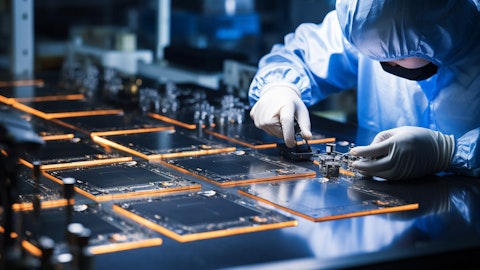We’ll have none of that problem in the JP because it’s built as a silicon carbide crystal growth operation. So very, very confident about that.
Operator: Thank you. The next question is from the line of Joshua Buchalter with TD Cowen. You may proceed.
Joshua Buchalter: Hey, guys. Thanks for taking my question. Actually a nice segue from your response to the previous question. I wanted to ask about sort of the time line and slope of the JP’s ramp. I guess any incremental color you can give us? I know you mentioned SOP by the end of the year, and then it sounds like back half of calendar ’25 is a reasonable time line for first power devices built on JP wafers. But any incremental color should the slope looks similar in directionally as what went on in Building 10? Thank you.
Gregg Lowe: Yeah, I think you have roughly the right kind of numbers there. And the only additional color I would add is what we said in our prepared remarks, which is we’re going to be installing crystal growers in there next month. So the facility is ready for installation of crystal growers. We’re not going to energize them in produce wafers until the back half of this calendar year. But I think all of the timing that you just talked about feels pretty reasonable. And I would say at this point, the team has done a great job. That was a forest not too long ago, and now is a giant crystal growth factory, and at this point, we’re on schedule.
Operator: Thank you. The next question is from the line of Vivek Arya with Bank of America. You may proceed.
Vivek Arya: Thank you. Actually got two questions. First, Neill, could you just repeat the gross margin outlook you gave for December. I think you gave the different moving parts. But if you could help kind of quantify what you see as gross margins heading into December? And then Gregg, my question is how do you handle situations where you are bidding for the same EV business that your materials customers are also bidding for?
Neill Reynolds: Yes. So first, on the gross margin front, just if you think about number one, in the current quarter, we’re going to be about flattish right around the 16.5% and that’s really based off of two things. One is, we’ll have a drag of about 100 basis points just off the leverage of the underutilization just on the lower revenue, but underlying performance offsetting that by about 100 basis points. So continuing to see good execution, as you think about the underlying ability to generate better costs and better margin profiles. As we move out to the June quarter, I think previously, we had talked kind of about a 20% marker. I think that moves out about a quarter. So June quarter, you’re probably talking about kind of mid to high teens based on what we’re looking at now as we start to push more product through Mohawk Valley.
So really Mohawk Valley will start to generate not just more volume. But as we push more product through there, we really like the cost structure and of course you get the benefit of the volume over that underutilization. The remainder of the year as you get out to December, you should see kind of a linear improvement, Vivek, in terms of margin beyond that. Like I said, out beyond June into September, we’ve been pushing that 20% marker out of quarter to the September quarter. However, when the JP comes online from a production perspective and think about that in that kind of March, June time frame of 2025, those underutilization costs will then come out of OpEx and we’ll need to put those into gross margin. We should be exiting the year, year about $15 million.
You could see it grow up to even $25 million or so before it makes that move. So that’s just something to consider from a modeling perspective as you get out beyond December and into the March and June quarters of 2025 as we start to bring the JP online.
Gregg Lowe: And then, Vivek, in terms of the other question, I would say, number one, our materials customers are exactly that. They are customers of ours. We treat them as such. We have quality meetings with them. We have typical quarterly program reviews and things like that. So we treat them as customers as we are — as they are definitely helping us convert the power electronics market from silicon to silicon carbide. I can tell you that when I joined the company six years ago or so, I believe there was one OEM that was committed to using silicon carbide in an inverter. And of course, that was Tesla. Today, I don’t know every single OEM, but I actually can’t name an OEM that isn’t using silicon carbide, maybe not across their entire platform, but they’re using silicon carbide in some of their models.




